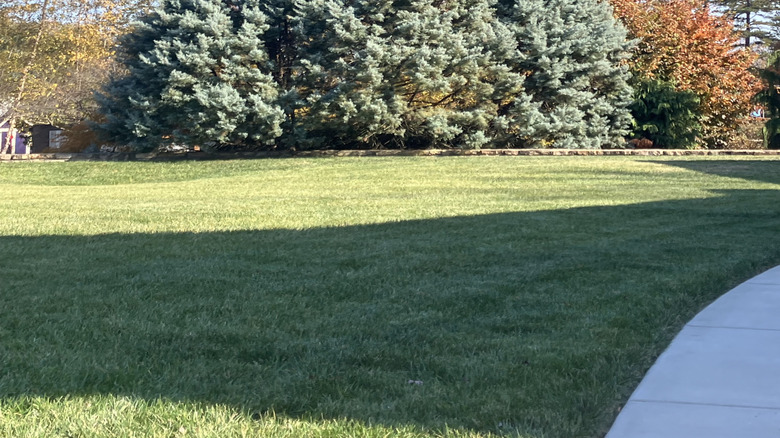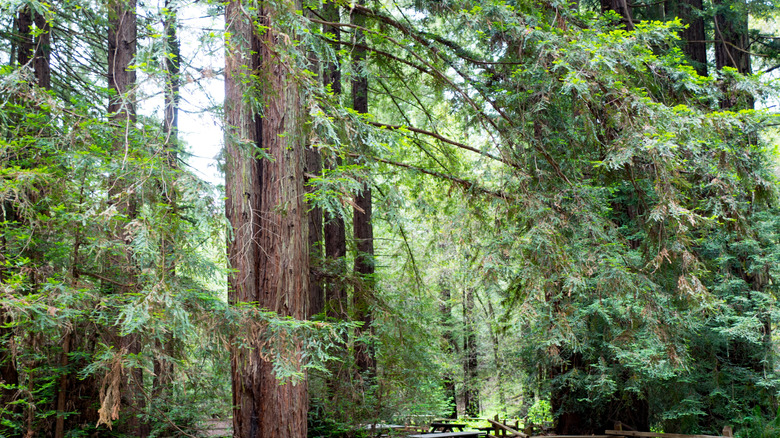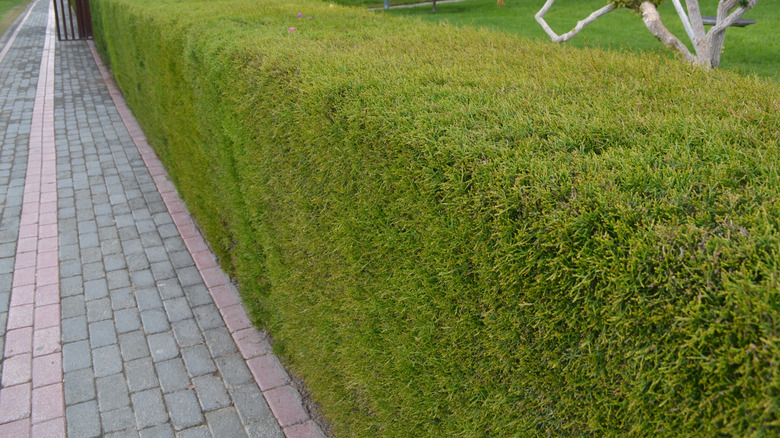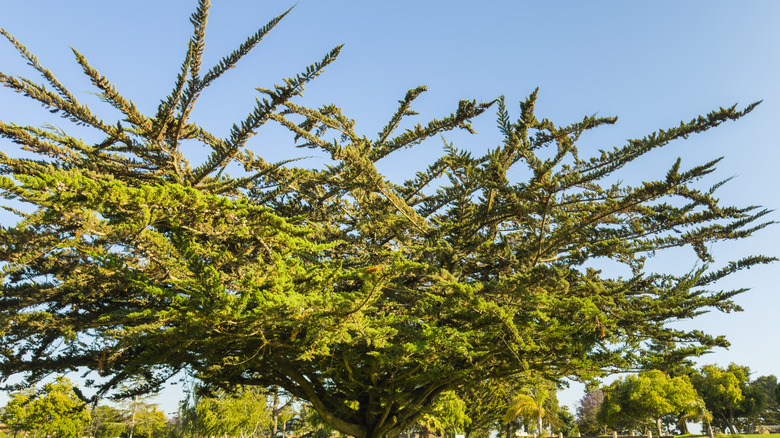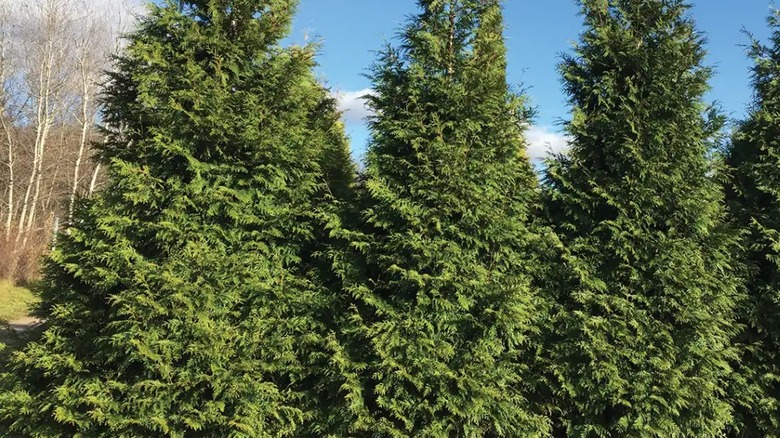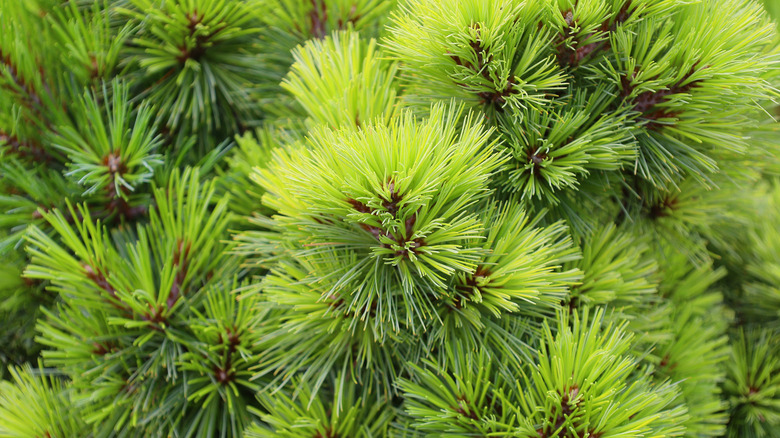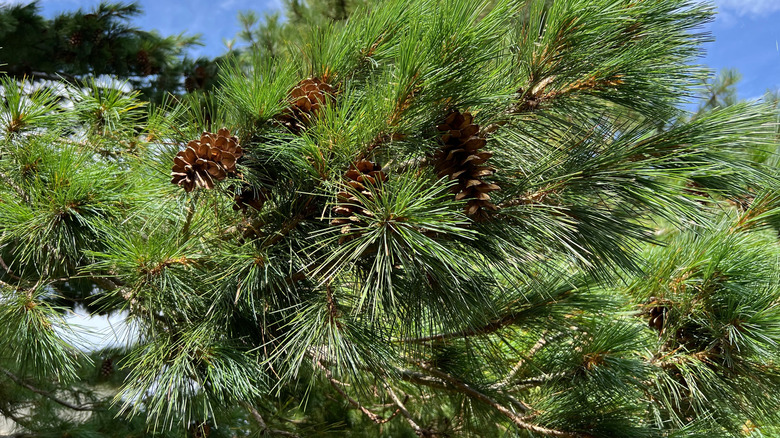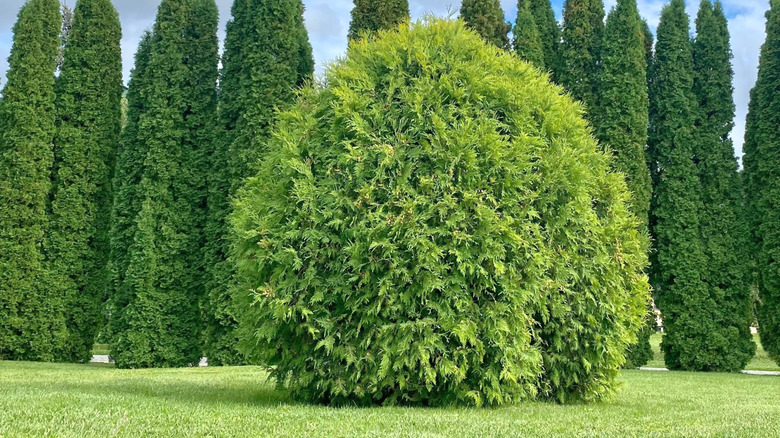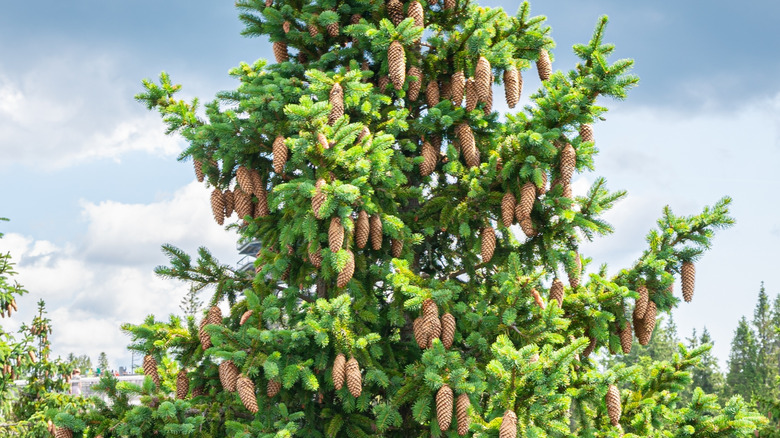Beautiful And Fast-Growing Conifers That'll Add Privacy To Your Yard
Privacy matters! You shouldn't have to worry about being on display when enjoying your backyard. Sadly, putting up fences can be financially and physically draining, and doesn't exactly make the prettiest sight. However, there's an easier way to create privacy without breaking the bank. Cue: Fast-growing conifers, like 'Carolina Sapphire,' coast redwood, Green Giant arborvitae, Leyland cypress, and Norway spruce.
The biggest advantage of growing conifers is that they retain their foliage even through the winter, providing year-round privacy and lush greenery to property owners while serving as winter habitat to the local wildlife. To ensure your natural privacy screen lasts a long time, diversify your plantings. So, instead of planting a single species, incorporate different species in mini clusters. Or, where space allows, create staggered rows of different types of conifers. That way, you can minimize the spread of any pest or disease infestation that could kill your screen overnight. Incorporate plants with different heights, textures, and forms for a more enriched design. Note that despite their vigorous growth, trees can take between four to eight years to fill out the space. Many of the conifers listed below grow over 2 feet on average in a year and produce dense, lush foliage that muffles noise, while carving out a private, outdoorsy retreat.
Grow 'Carolina Sapphire' Arizona cypress for instant privacy in dry, sunny yards
Capable of gaining between 3 and 5 feet every year, 'Carolina Sapphire' Arizona cypress (Hesperocyparis arizonica 'Carolina Sapphire') is one of the fastest-growing conifers you can add to your yard. It looks highly ornamental, too. Its aromatic, electric blue or silverish foliage fills out into a pyramidal form, assuming a final size that's 15 feet wide and 40 feet high in ideal conditions.
'Carolina Sapphire' is ideal for dry yards where the sun beams down throughout the day; though it does tolerate moderate shade for short periods. The heat and drought tolerance of these conifers is uncommon in the world of evergreens. After establishment, they continue performing even with minimal watering. Plus, they're fairly low-maintenance. In fact, you don't have to fertilize them as long as there's no leaf discoloration. Moreover, pruning is unnecessary unless you're removing any dead or decaying wood, containing size where desired, or shaping into topiary. Pests, including deer, care little about its foliage. To create the needed privacy, space the trees about 8 feet apart if planted in straight rows; reduce the spacing to 6 feet if staggering for a natural screen. Maintain about 4 feet of distance from the neighbor's fence to avoid overcrowding. They're hardy in zones 7 through 9.
Utilize coast redwood for screening multistoried homes
Known as the world's tallest tree and California's state tree, the coast redwood (Sequoia sempervirens) is another fast-growing specimen that can be grouped for a privacy screen. When you purchase this beauty, it will probably be around 5 to 6 feet tall, but it grows an additional 3 to 5 feet, until its mature, cultivated forms top out at over 60 feet. If not constrained by utility lines, you can leave this tree unpruned, ensuring no neighborly eyes gaze into your second-floor bedroom. On the flip side, you get to enjoy shade during sweltering summer months, courtesy of the dense foliage. The winter color popping off their orange bark and dark green leaves adds visual interest. Just leave plenty of space when you plant these trees, as they can become enormous. For screening, space the trees about 15 feet apart and keep them well clear of your home and electrical lines. Since their shallow roots intertwine with each other, they help stabilize your living screen and provide wind protection.
Coast redwoods can survive thousands of years. Since deer, fungi, and pests don't attack the tree due to its high tannin content, its survival rates go up dramatically. So, by giving them a home in your yard, you're almost bequeathing a living legacy to your offspring. However, be mindful of their location. While coast redwoods tolerate heavy shade, their growth slows down to mere inches in such conditions. They also lose their vigor if planted on dry sites. So, locate them in rain or coastal gardens with full sun exposure. If growing them inland, offer regular irrigation, especially in the summer. Coast redwoods are cold-hardy in zones 7 to 9.
Plant Green Giant arborvitae for a quick, easy-care hedge
When seeking fast-growing trees for a natural privacy screen in your yard, Green Giant arborvitae (Thuja standishii × plicata 'Green Giant') is a near staple. Depending on the site's conditions, it can grow between 3 and 5 feet in a year (sometimes more), until it tops out at 60 feet, or occasionally taller if planted in ideal conditions. It holds its shape through the years, so you won't have to prune it too regularly. Its lush branches look attractive year-round and double as nesting cover for birds.
One of the biggest advantages of growing Green Giant arborvitae is its wide adaptability. It can survive in all soils, including heavy clay or lean rocky soil, and is indifferent to their texture and pH levels. Summer rains and routine garden fertilization usually suffice, paired with four hours of direct sun exposure (though it can handle more sun). Apart from the prying eyes of strangers, their grouped mass also deters deer from peeking deeper into your yard. Green Giant arborvitae has few serious pest problems, so you won't have to maintain a chemical regime. In straight rows, space the trees 5 feet on center, raising the distance to 8 feet for alternate rows. They grow successfully in zones 5 through 8.
Use Leyland cypress for a solid, fast-growing hedge in infertile soils
Leyland cypress (× Cuprocyparis leylandii) is a vigorous grower, capable of adding an extra 3 feet annually. In fact, it's known to grow nearly 50 feet tall within a span of 1½ decades. The best part, though? Remarkably adaptable, it maintains strong growth even in relatively infertile or sandy soils — provided they drain well.. Since Leyland cypress has a columnar shape, it forms a symmetrical hedge that makes the yard look cohesive. In case you aren't a fan of its mature size, trim it down to the desired height — this conifer will spring back in no time. Additionally, you can play around with colors. While the standard specimens grow bluish-green needles, cultivars like 'Castlewellan' and 'Silver Dust' show yellow or white variegations.
Multiple Leyland cypress trees can be spaced about 8 feet apart for a solid privacy screen. But if you'd like to block out noise and wind, too, grow them closer (6 feet will do the trick). Keep in mind, though, that you'll have to water the site more frequently in the latter scenario, or the trees will lose their vigor. Although Leyland cypress trees are highly adaptive to most soils and light conditions, they require considerable maintenance. Cankers and bagworms can make quick work of the tree, especially after a drought in the western U.S. states. The adaptive range spans from zones 6 to 9.
Plant Monterey cypress to create a privacy screen in coastal areas
A Californian native, Monterey cypress (Hesperocyparis macrocarpa) is a rapid-growing conifer that's commonly cultivated on the West Coast. In a year, it can acquire an additional 3 feet in height, until it's about 70 feet tall. When the trees are newly planted, they feature a uniform, columnar form, transforming later into a more asymmetrical, windswept look. In case you don't want this outcome, opt for narrow-shaped cultivars — just know that they might not grow as fast.
Monterey cypresses can handle sea breezes like a champ and thus are an ideal placement in coastal gardens. This way, you can also enjoy a whiff of lemony fragrance emanating from their foliage along with the nesting birds and butterflies visiting these needled evergreens. Even though they tolerate drought, they thrive in well-watered soils and much prefer moist environments. Hardy in zones 7 through 10, Monterey cypress shouldn't be grown in hot sites because heat-stressed trees become vulnerable to canker. Also, be prepared for some fall clean-up, as the shed cones can be messy. Space them about 5 to 6 feet apart for quick privacy, but you'll need to shear them annually for maintenance and to prevent overcrowding.
Use Loblolly pines for a dense screen in poorly-draining yards
Loblolly pines (Pinus taeda) are fast-growing privacy trees you can enjoy year-round for their looks and security. Believed to be among the most vigorously-growing pines, loblolly pines can add about 3 feet in annual growth. In cultivated soils, they max out at under 50 feet, but can reach upwards of 90 feet in the wild, limiting their use to large yards. Since loblolly pines are clothed in slender, green needles year-round, they offer food and cover to elfin butterflies, imperial moths, bald eagles, squirrels, chickadees, and bobwhites. However, their foliage can turn bronze or brown if nutrients or water access are low, or if there is an exceptional period of cold.
The name "loblolly," meaning "mud puddle" or "thick broth," hints at the pine's natural preference for low, moist ground. True to its name, the loblolly pine thrives in humid, bottomland soils — though it favors moist, well-drained conditions over standing water. As a single specimen can grow nearly 40 feet wide, you must space the pines at least 25 feet apart for privacy — any closer and you would've to thin them out. Also, note that though conical when young, they'll lose their lower limbs as they mature, assuming an oval canopy, so if you're looking for a long-term privacy screen (over 8-10 years), this might not be the best option. Loblolly pines are native to the southeast U.S., enjoy full sun, and are hardy in zones 6 through 9.
Utilize Spring Grove western arborvitae for a fast-growing hedge that deters deer
Those seeking deer-resistant shrubs to landscape their yard and protect their garden, while also creating privacy, would find Spring Grove western arborvitae (Thuja plicata 'Grovepli') an excellent choice. These conifers can add 2 to 3 feet of height per year when young. They typically mature at around 25 feet tall, occasionally exceeding 30 feet in optimal conditions. Their forest green needles are braided densely enough to offer a solid screen that you may sculpt into any other form if desired, as they take well to pruning. Better yet, they retain their hue and form, no matter the cold or snow.
Spring Grove western arborvitae should be spaced about 5 to 6 feet wide for an evergreen hedge. To ensure the plants remain vigorous, locate them in moist sites with fertile soil. Since they can do with mere four hours of direct sun exposure, they're ideal in woodland lots, especially those languishing from constant deer herbivory. You may also utilize them in a perimeter that remains shaded for the majority of the day. Hardy to –25 degrees Fahrenheit and well-suited to Zones 5 through 8, Spring Grove western arborvitae is both resilient and low-maintenance. Once established, it tolerates moderate heat and brief drought, though it thrives best in moist, cool soil. Because its branches often extend close to the ground — sometimes only 1 to 2 feet up — you may wish to prune the lower limbs to create clearance.
Grow eastern white pines for a long-lasting, soft screen with pollinator benefits
Imagine planting fast-growing trees that make your yard a pollinator haven while offering ample privacy! That's precisely what you get by growing eastern white pines (Pinus strobus). In their youth, these conifers gain between 2 and 3 feet in height every year, showing off a dense, pyramidal form that blocks unsightly views. From butterflies to birds, including robins, finches, waxwings, and chickadees, they attract a plethora of pollinators with their seeds. Plus, they survive in landscapes for hundreds of years. However, their growth rates will diminish with age, and they'll take on a more open form after shedding their lower limbs, providing a lighter screen. If that's inconvenient, opt for the cultivar 'Fastigiata,' which is better at retaining its columnar habit.
Since eastern white pines can't handle heat or drought, they're mostly grown in cold climates of zones 3 through 8. Be mindful of their location, ensuring they're planted away from your home or roads. That's because they're prone to breakage from winds and do not tolerate salt drift. Also, don't grow them in heavy clay or alkaline soils, or their needles may turn yellow. Space them about 8 to 15 feet away for a soft privacy screen.
Plant western white pines for light screening in a cool, moist climate
Originating in the states lining the Pacific Coast, western white pine (Pinus monticola) is the matching counterpart of the eastern white pine in form and attributes. It grows rapidly, gaining an additional 2 feet every year. Though hardy, it performs best in moist, well-drained soils rather than truly harsh conditions. Like its eastern associate, western white pines are popular among birds for nesting material as well as butterflies and moths whose larvae feed on their bluish-green needles.
When using western white pines for privacy, bear in mind that their mature specimens may eventually drop their lower limbs. This may reduce the ground-level privacy, which can be rectified by interplanting species like spruce or adding understory vegetation. Depending on how quickly you want the screen, space them about 6 to 15 feet wide on center. These trees prefer cool, moist, well-drained mountain soils and do best in moderate temperatures with regular precipitation. If you're up for a challenge, these fast-growing trees can be grown from seeds after cold stratification for four months. They're cold-resilient in zones 3 through 8.
Build a privacy screen with American Pillar arborvitaes in confined spaces
American Pillar arborvitae (Thuja occidentalis 'American Pillar') features a dense network of bright green needles. As a result, it forms a solid screen that, apart from unsightly views, blocks out urban noise and gusts of wind. It grows fast, too. It can grow over 3 feet every year once established, until it's about 23 feet high. Afterward, the annual growth averages to about 2 feet, with the tree topping out at 30 feet. Since 'American Pillar' has a symmetrical, slender form that doesn't exceed 5 feet at maturity, you can fit it in the narrowest backyards without any hassle. You can even use it to frame any second-story decks, patios, balconies, or terrace. It's also ornamental and bushy enough to shroud swimming pools in privacy.
American Pillar arborvitae can tolerate temperature dips to -40 degrees Fahrenheit, placing its adaptive range in zones 3 through 8. It requires at least four hours of direct sunlight, but can tolerate plenty more due to its good heat tolerance. Moreover, it can handle drought stress like a trooper after establishment. Unless shaping, you can leave these conifers unpruned. If you want the trees to quickly grow into each other, plant them 2½ feet away. Otherwise, leave about 4 feet of distance between them. Although deer avoid them, know that deer-resistant plants are hardy against a little nibble — but not all. So, don't skimp on netting.
Norway spruce forms a massive screen that provides privacy and wind protection in northern states
When young, Norway spruce (Picea abies) grows about 3 feet annually, forming a thick screen within three years of planting. While the growth rates diminish as it ages, it still reaches about 75 feet in 50 years. The thick foliage blocks out views and sounds, making it useful in large yards or recreational spaces with a straight view of the roads. Lined up, Norway spruces are also valuable in woodland lots or near open fields and meadows under deer pressure, as their glossy needles don't make for sumptuous snacks. Since this beautiful tree can survive in extremely windy environments, it can also be used as a windbreak.
As Norway spruce can not handle heat or drought, it's usually planted in cool climates. It is hardy in Zones 2 through 7 and grows best in moist, well-drained, slightly acidic soil. Although Norway spruce can take some shade, you must maximize sun exposure for a fuller look. Spacing for privacy can be tricky, as Norway spruces can extend over 25 feet wide when fully mature. Given that, opt for staggered planting and maintain a 15-foot distance between the trees. The falling cones can make the landscape messy, but can be used for pretty Christmas decorations. With all of this being said, make sure this conifer isn't considered invasive in your area before planting. It can aggressively self-seed in areas of the Northeast.
In tough, urban conditions use 'Yoshino' Japanese Cedar for a fast-growing, lush hedge
'Yoshino' Japanese Cedar (Cryptomeria japonica 'Yoshino') is a gorgeous conifer with heavily textured, bluish-green needles. These needles are knitted closely enough to offer privacy and quell unwanted sounds. Moreover, it has a fast growth rate. Juvenile trees shoot up nearly 4 feet in the initial years, slowing down to a lifetime average of about 18 to 24 inches. These evergreens mature to heights of 30 feet, while measuring 20 feet across. In extreme cold winters, their foliage may show subtle signs of browning.
'Yoshino' Japanese cedar stands apart from the lot in its adaptability to urban conditions. From soil compaction and poor drainage to urban pollution, it handles some tough growth conditions. But you must space the trees correctly. When establishing a privacy screen or hedge, don't plant them closer than 8 feet. This will minimize the need for pruning and the risk of leaf blight, as the foliage has sufficient room to grow into its natural, pyramidal form. If you can't wait that long for the foliage to fill out, consider planting the conifers alternately in multiple rows. 'Yoshino' fares best in full sun in zones 5 through 8, but will benefit from afternoon protection in the southern range during peak summer heat. Just note that in some regions of the US, this evergreen is considered invasive and should not be planted.

